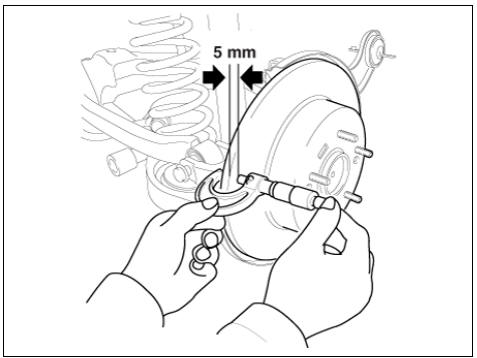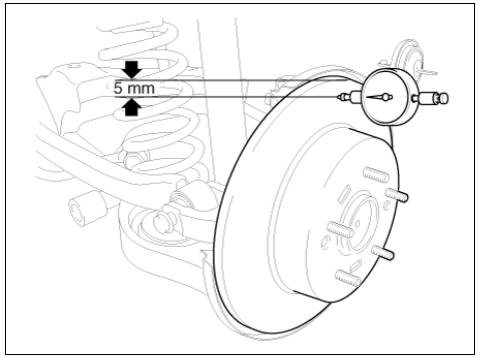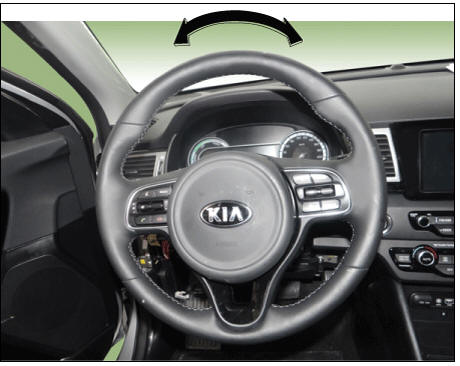KIA Niro: Rear Brake
Rear Brake Disc Thickness Check
- Check the brake pads for wear and fade.
- Check the brake disc for damage and cracks.
- Remove all rust and contamination from the surface, and measure the disc thickness at 8 points, at least, of same distance (5mm) from the brake disc outer circle.
Brake disc thickness
Standard: 10 mm (0.39 in)
Service limit: 8.4 mm (0.33 in)
Deviation: less than 0.01 mm (0.0004 in)

- If wear exceeds the limit, replace the discs and pad assembly left and right of the vehicle.
Rear Brake Pad Check
- Check the pad wear. Measure the pad thickness and replace it, if it is less than the specified value.
Pad thickness
Standard value: 10.0 mm (0.3937 in.)
Service limit: 2.0 mm (0.0787 in.)
- Check that grease is applied, to sliding contact points. Check for metal damage to the pad and backing.

Rear Brake Disc Runout Check
- Place a dial gauge about 5mm (0.2 in.) from the outer circumference of the brake disc, and measure the runout of the disc.
Brake disc runout Limit: 0.05 mm (0.002 in.) or less (new one)

- If the runout of the brake disc exceeds the limit specification, replace the disc, and then measure the runout again.
- If the runout does not meet the limit specification, remove the disc, turn it 180º and reinstall. Then check the runout of the brake disc again.
- If the runout cannot be corrected by changing the position of the brake disc, replace the brake disc.
Inspection
- Check the drive shaft boots for loose clamps, cracks, grease leaks, kinks or damage.

Inspection
Check whether the stroke is within specification when the parking brake pedal is depressed with 66 lb, 294 N(30 kg) of force. Also, the parking brake alone should securely hold the vehicle on a fairly steep grade. If the stroke is more or less than specified, have the parking brake adjusted by an authorized Kia dealer.
Stroke : 6 - 7 notch
Inspection
- Check the steering wheel free road.
(1) Turn the steering wheel so that the front wheels can face straight ahead.
(2) Measure the distance the steering wheel can be turned without moving the front wheels.
Standard value: 30mm (1.18in.) or less
(3) If the play exceeds standard value, inspect the steering column, shaft, and linkages.

- Check the steering linkage for looseness or damage.
(1) Check that the dust parking and cap are not damaged.
(2) Check that the Bellows bands are not loose.
(3) Check that the steering gear box is not damaged.
(4) Check that the column and shaft are properly connected to the steering gear box.
Inspection
Visually check, must be free from injurious flaw and crack.
Inspection
Visually check the loose mount bolt.
READ NEXT:
 Tire Rotation
Tire Rotation
Inspection
Check the tire pressure.
16(inch) : 2.5kg/cm²(36psi)
18(inch) : 2.5kg/cm²(36psi)
Tire Rotation
Checking For Pull And Wander
If the steering pulls to one side, rotate the tires according to the
following wheel rotation proced
 Checking Refrigerant Specifications
Checking Refrigerant Specifications
Check refrigerant specifications label inside engine room.
Examples
R-134a
R-1234yf
If refrigerant specifications label is not visible, check the
refrigerant service port diameter.
High pressure side
R-134a
R-1234yf
Low p
 Refrigerant System Service Basics (R- 134a)
Refrigerant System Service Basics (R- 134a)
For the electric compressor using high-voltage, use POE oil with high
insulation property.
Use a separate equipment (refrigerant recovery / charger) exclusive for
hybrid vehicle maintenance to prevent infusion of PAG oil of non-hybrid
v
SEE MORE:
 LCD display messages
LCD display messages
Shift dial SBW type of LCD display messages
Message/ Content
A: Shifting conditions not met. Reduce speed, then shift
When driving speed is too fast to shift the gear.
A: Error. Press brake and shift to R and then D
When the brak
 Vehicle parasitic current inspection
Vehicle parasitic current inspection
Using the Ammeter
Turn the all electric devices OFF, and then turn the ignition switch OFF.
Close all doors except the tailgate, and then lock all doors.
Disconnect the tailgate latch connector.
Wait a few minutes until the vehicle's electr
Categories
- Home
- KIA Niro EV, Hybrid - Second generation - (SG2) (2021-2024) - Owner's manual
- Kia Niro - First generation - (DE) (2017-2022) - Service and Repair Manual
- Contact Us
